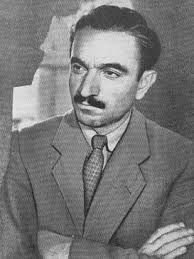A prolific novelist, Sero Khanzadian also became one the best exponents of the Soviet Armenian historical novel from the 1960s.
He was born on December 3, 1915, in Goris (Siunik). He graduated from the pedagogical school of the city in 1934, and the same year he published his first short story in the periodical Karmir Zangezur. He worked as teacher from in 1934-1941 in the nearby villages of Tatev and Khnatzakh until he was mobilized to fight in World War II (1941-1945).
He became member of the Writers Union of Armenia in 1950, the same year he published his first book, the novel People of Our Battalion, with the war as subject. His next work, the two-volume novel Land, brought him critical recognition. His subject this time was the rural exodus, showing that the well-being of the residents of the village of Karakert was not solved by migration to the Ararat Plain, but by breaking the boulders and making the land flourish.
He published several collection of young teens literature and two collections of shorts stories from 1955-1961, Red Lilies (1958) and “The Wealth in the Mountains” (1961).
The historical novel “Mkhitar Sparapet” (1961) consecrated Sero Khanzatian’s name in Armenia and the Diaspora with four printings in Yerevan, Beirut, and Cairo from 1961-1963. He continued the tradition of the Armenian historical novel with one heroic episode of history interpreted from a contemporary viewpoint. This was the rebellion of David Bek and his successor Mkhitar Sparapet from in 1725-1730 in Siunik against the Persian rule and the Ottoman invasion.
He continued producing an outpouring of volumes, mostly dedicated to contemporary subjects: Lost Paths (1964), Kajaran (1965), The Burned House (1965), Book of Events (1966), After the Rain (1969), Why, Why? (1970), Three Years, 291 Days (1972), The Daybreak at the Sevan (1974), Speak, Mountains of Armenia (1976).
Sero Khanzatian became a literary advisor of the Writers Union of Armenia in 1972. He earned the title of Emeritus Figure of Armenia in 1974 and won the State Prize of Armenia in 1977 for his battlefront diary Three Years, 291 Days, published five years before. He also received various military and state decorations over the decades.
In the last two decades of his life, Khanzadian’s literary work leaned towards Armenian history. He gave an original reconstruction of the Armenian remote past in his novel The Armenian Queen (1978), which was followed by other historical novels (The Arax is Becoming Muddy, 1985; Antranig, 1989; Shushi, 1991, and Garegin Nezhdeh, 1993) and autobiographical and memorialist works (With My Father and Without My Father, 1986; As I Remember It, 1988; Gharabagh Amid the Fire, 1998).
The writer was a frequent commentator on historical, literary, and current issues. Many of his works were translated into Russian and other languages, and two of his works, The Burnt House (retitled The Valley of Abandoned Tales, 1974) and Mkhitar Sparapet (1978, also known as The Star of Hope), were turned into movies.
Sero Khanzadian passed away in Yerevan on June 26, 1998. He was buried in the Pantheon of Komitas Park.
